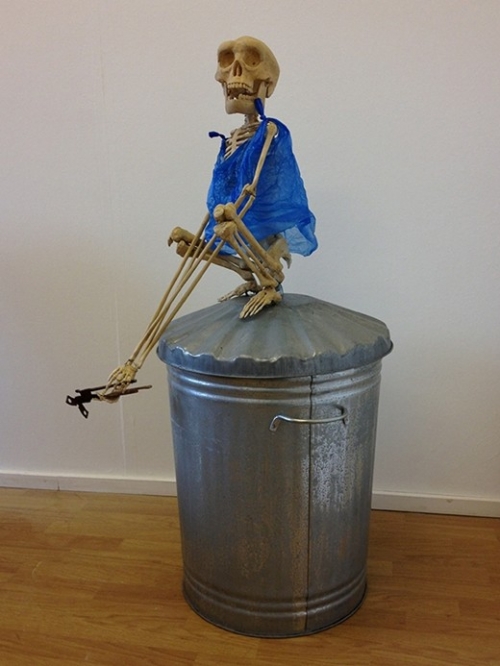AnOther magazine - In Pictures
Profile in AnOther Magazine, April 2013
During their collaboration over the last ten years, artists Shaun Doyle and Mally Mallinson have developed a reputation for their iconoclastic humour and vivid large-scale installations. Having shown at the Tate, the Saatchi Gallery, the ICA, and for numerous commissions and art fairs internationally, their current exhibition, Mum Man, sees the duo scaling down for the Paul Stolper Gallery in London. Mum Man is a collection of sculptures and drawings representing Doyle and Mallinson’s on-going fascination with religion and evolution, explored through three strands of their work: the boarded-up Wendy Squats resembling children’s toy houses, the Handyman Bronzes based on a Medieval image of Jesus impaled by tools of labour, and the Ecce Homo sculptures and drawings exploring the possibilities of human evolution. We spoke with Doyle and Mallinson about scaling down, their fascination with artefacts, and the collaborative process.
Was it difficult to make smaller pieces than you usually do for the current show?
Mally Mallinson: Normally our smaller sculptures fit together as part of a larger installation, whereas here we were trying to create a coherent story across three different strands of our work, so it was a challenge, but they all seem to sit really well together.
What inspired the Wendy squats?
Shaun Doyle: The ones here are actually smaller versions of the first piece we made together back when we started collaborating. At the time we also made a thing called Skippy, which was a plastic-looking skip full of moulded fly-tipped rubbish. This and the Wendy Squats might be something you buy for your child to prepare them for the disappointment of life.
- _ “Skippy and the Wendy Squats might be something you buy for your child to prepare them for the disappointment of life”_*
The Handyman bronzes are also based on previous works…
MM: Yes, the sculptures are all versions of pieces we’ve been working on for years in bigger versions. The largest sculpture in this show, the Handyman of Sorrows, is inspired by an 11th century wall painting where Jesus is being impaled by tools. It was a warning to people against working on the Sabbath. We updated the image with contemporary DIY tools because Sunday is now the day for home improvements.
You often return to religion as a theme in your work.
MM: Obviously religion is a major part of human evolution, so we’re always interested in that conflict between science and myth, or religion, and how they integrate and react with each other.
SD: Art is about belief as well, because you’re asking someone to suspend disbelief for a while and see your point of view.
What inspired the third strand of the exhibition, the Ecce Homo drawings and sculptures?
SD: A few years back we were commissioned to do a piece in Venlo, in the Netherlands. We wanted to do something related to the city and we found out that Eugene DuBois was buried there. He had discovered an important fossil that was a missing link at the time, so that’s the background story behind the pieces. The drawings, which represent popular or forgotten subcultures, were originally done in 2011, but this is the first time we’ve shown the series in its entirety. The sculptures, Ecce Homo Tesco, and Homo Tesco (Bin Boy), are human skeletons with extended arms, having evolved from dragging shopping bags.
MM: It’s taking on the idea of, where can humans go? How do we evolve? We’re looking at human evolution and culture from the imagined perspective of some sort of future anthropologist.
* “Art is about belief as well, because you’re asking someone to suspend disbelief for a while and see your point of view”*
How do you work together?
SD: Drawings are really easy because one person does something and the other person responds to it. It’s like a game of badminton. With the sculptures, it doesn’t seem to be important who does what as part of the process, because we’ve both been involved in the conception of the idea.
You seem to have a fascination with cultural artefacts – your works could easily have come from an extraordinary archaeological dig.
SD: I think archaeology is what ties the threads together. We like that as an overarching theme because the Paul Stolper gallery is located so close to the British Museum.
MM: I guess you could say our work is a cross between punk and archaeology. Maybe we should establish a Doyle and Mallinson Museum…
Doyle and Mallinson, Mum Man, is at the Paul Stolper Gallery until April 27.
Text by Ananda Pellerin
Ananda Pellerin is a London-based writer and regular contributor to anothermag.com.
